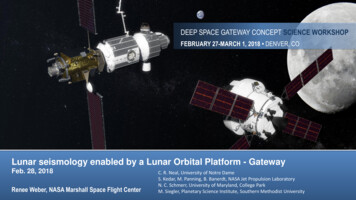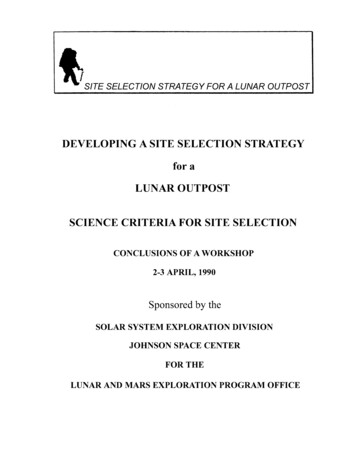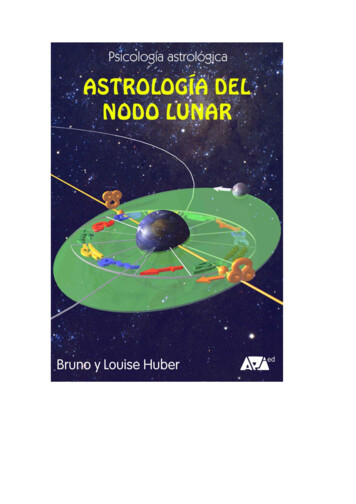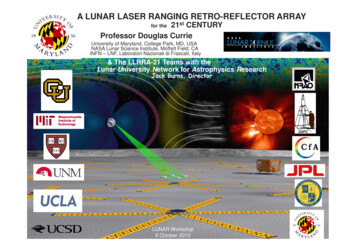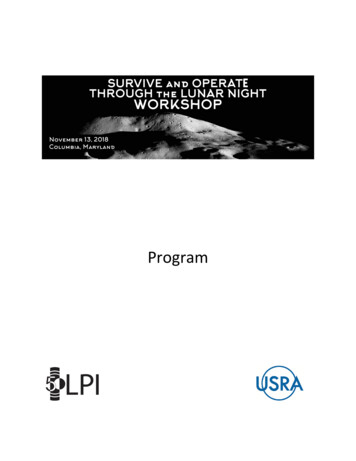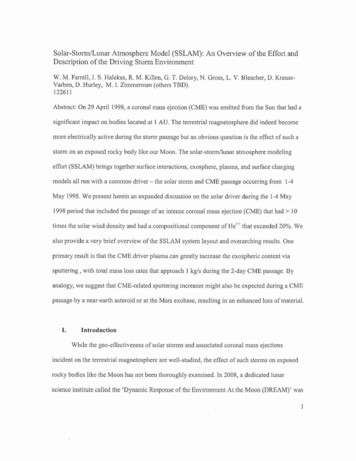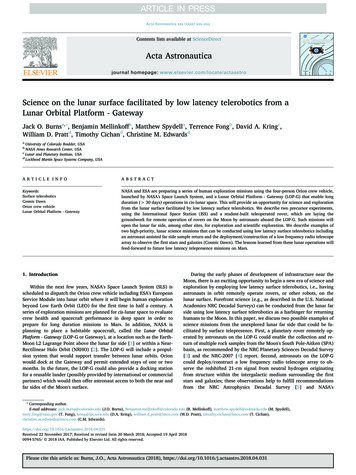
Transcription
Acta Astronautica xxx (xxxx) xxx–xxxContents lists available at ScienceDirectActa Astronauticajournal homepage: www.elsevier.com/locate/actaastroScience on the lunar surface facilitated by low latency telerobotics from aLunar Orbital Platform - GatewayJack O. Burnsa, , Benjamin Mellinkoffa, Matthew Spydella, Terrence Fongb, David A. Kringc,William D. Prattd, Timothy Cichand, Christine M. EdwardsdaUniversity of Colorado Boulder, USANASA Ames Research Center, USAcLunar and Planetary Institute, USAdLockheed Martin Space Systems Company, USAbA R T I C LE I N FOA B S T R A C TKeywords:Surface teleroboticsCosmic DawnOrion crew vehicleLunar Orbital Platform - GatewayNASA and ESA are preparing a series of human exploration missions using the four-person Orion crew vehicle,launched by NASA's Space Launch System, and a Lunar Orbital Platform - Gateway (LOP-G) that enable longduration ( 30 days) operations in cis-lunar space. This will provide an opportunity for science and explorationfrom the lunar surface facilitated by low latency surface telerobotics. We describe two precursor experiments,using the International Space Station (ISS) and a student-built teleoperated rover, which are laying thegroundwork for remote operation of rovers on the Moon by astronauts aboard the LOP-G. Such missions willopen the lunar far side, among other sites, for exploration and scientific exploration. We describe examples oftwo high-priority, lunar science missions that can be conducted using low latency surface telerobotics includingan astronaut-assisted far side sample return and the deployment/construction of a low frequency radio telescopearray to observe the first stars and galaxies (Cosmic Dawn). The lessons learned from these lunar operations willfeed-forward to future low latency telepresence missions on Mars.1. IntroductionWithin the next few years, NASA's Space Launch System (SLS) isscheduled to dispatch the Orion crew vehicle including ESA's EuropeanService Module into lunar orbit where it will begin human explorationbeyond Low Earth Orbit (LEO) for the first time in half a century. Aseries of exploration missions are planned for cis-lunar space to evaluatecrew health and spacecraft performance in deep space in order toprepare for long duration missions to Mars. In addition, NASA isplanning to place a habitable spacecraft, called the Lunar OrbitalPlatform - Gateway (LOP-G or Gateway), at a location such as the EarthMoon L2 Lagrange Point above the lunar far side [1] or within a NearRectilinear Halo Orbit (NRHO) [2]. The LOP-G will include a propulsion system that would support transfer between lunar orbits. Orionwould dock at the Gateway and permit extended stays of one or twomonths. In the future, the LOP-G could also provide a docking stationfor a reusable lander (possibly provided by international or commercialpartners) which would then offer astronaut access to both the near andfar sides of the Moon's surface.During the early phases of development of infrastructure near theMoon, there is an exciting opportunity to begin a new era of science andexploration by employing low latency surface telerobotics, i.e., havingastronauts in orbit remotely operate rovers, or other robots, on thelunar surface. Forefront science (e.g., as described in the U.S. NationalAcademies NRC Decadal Surveys) can be conducted from the lunar farside using low latency surface telerobotics as a harbinger for returninghumans to the Moon. In this paper, we discuss two possible examples ofscience missions from the unexplored lunar far side that could be facilitated by surface telepresence. First, a planetary rover remotely operated by astronauts on the LOP-G could enable the collection and return of multiple rock samples from the Moon's South Pole-Aitken (SPA)basin, as recommended by the NRC Planetary Sciences Decadal Survey[3] and the NRC-2007 [4] report. Second, astronauts on the LOP-Gcould deploy/construct a low frequency radio telescope array to observe the redshifted 21-cm signal from neutral hydrogen originatingfrom structure within the intergalactic medium surrounding the firststars and galaxies; these observations help to fulfill recommendationsfrom the NRC Astrophysics Decadal Survey [5] and NASA's Corresponding author.E-mail addresses: jack.burns@colorado.edu (J.O. Burns), Benjamin.mellinkoff@colorado.edu (B. Mellinkoff), matthew.spydell@colorado.edu (M. Spydell),terry.fong@nasa.gov (T. Fong), kring@lpi.usra.edu (D.A. Kring), william.d.pratt@lmco.com (W.D. Pratt), timothy.cichan@lmco.com (T. Cichan),christine.m.edwards@lmco.com (C.M. 04.031Received 22 November 2017; Received in revised form 20 March 2018; Accepted 19 April 20180094-5765/ 2018 IAA. Published by Elsevier Ltd. All rights reserved.Please cite this article as: Burns, J.O., Acta Astronautica (2018), https://doi.org/10.1016/j.actaastro.2018.04.031
Acta Astronautica xxx (xxxx) xxx–xxxJ.O. Burns et al.are more streamlined than remote robotics [7].When uncrewed, the Gateway will be operated like other roboticplanetary missions with remote flight control teams commanding thespacecraft from Earth. One of the Gateway's services will be to providecommunication relay for robotic spacecraft (landers, planetary rovers,etc.), which will be especially critical for any future far side surfaceassets. The lunar far side is of scientific interest, but currently nocommunications architecture exists there to support scientific missions.The LOP-G can act as a communications relay to any surface or orbitalmissions, including international missions, and can transmit the databack to scientists on Earth via either the High Gain Antenna (HGA) orthe optical communication terminal. The science and video data collected by the LOP-G is most efficiently downlinked using an opticalcommunication system. Optical communication enables a significantincrease to downlink bandwidth capability compared to traditionalradio frequency (RF) communication. For example, NASA's Lunar LaserCommunication Demonstration (LLCD) exhibited a record-breakingMoon to Earth download rate of 622 Mbps [8]. The Gateway will alsohave similar capabilities as the Mars orbiters, including Mars Reconnaissance Orbiter, Mars Odyssey, and MAVEN, which providecommunications between the Mars rovers and Earth [9]. With thecurrently planned Near Rectilinear Halo Orbit (NRHO), the Gatewaywill be in a position to provide more than 60% communication coverage for a large portion of the lunar far side, which is greater than therelay support coverage provided by the current Mars fleet [10]. In addition, the LOP-G could provide a range of other surface mission support services, including remote sensing and imaging, “orbital computing” (high-performance computation and data storage similar toterrestrial “cloud computing”), positioning, and timing.For both crewed and uncrewed lunar mission support, the Gatewaycommunications architecture is designed to exchange commands andtelemetry via space to ground, space to space, and space to lunar surface links. The LOP-G communications system has deep space heritagefrom planetary spacecraft and Orion to meet the various communication needs and utilizes channels across the frequency spectrum including X-band, S-band and optical communication. While the LOP-G isin lunar orbit without Orion, commands and telemetry will be exchanged over an X-band link with the Deep Space Network (DSN) via a2 m HGA. This communication link will then be used for remote operations of the Gateway as an uncrewed robotic spacecraft. It will alsobe the path for downlinking the relay data from other robotic missions.During rendezvous and proximity operations, the LOP-G will communicate with Orion over S-Band. The LOP-G will leverage S-Band components developed for Orion to ensure compatibility and affordability.Once docked, data will be exchanged between LOP-G and Orion via ahardline connection. Information from Orion can be downlinked to theDSN via the LOP-G's HGA; and vice versa, information from the LOP-Gcan be downlinked via Orion's Phased Array Antennas that are part ofits S-Band system.There are several key lunar far side science objectives discussed inthis paper, which have been identified by the planetary science andastrophysics communities as top priorities and can be supportedthrough use of the Gateway. For example, the relay capability willallow teleoperation from Earth of lunar robots to perform surfaceimaging, in-situ chemical and isotopic analyses, and sample collectingopportunities in scientifically-rich sites such as the Schrödinger basin[11]. Sample collection from Schrödinger and other locations is required to resolve the questions such as in the NRC-2007 report outlining the Scientific Context for Exploration of the Moon. The LOP-G couldalso provide a platform for the continuous observation of impacts ontothe lunar surface [12]. This capability would provide an enhanced assessment of impact hazards for lunar surface operations and identifyfresh surface excavation sites suitable for geologic and in-situ resourceutilization studies.Astrophysics Roadmap (Cosmic Dawn Mapper [6]).We begin this paper in Section 2 with an elaboration of the capabilities of the Lunar Orbital Platform - Gateway and Orion in cis-lunarspace that will enable robotic missions on the lunar surface with particular emphasis on the lunar far side. In Section 3, we describe experiments using the ISS and a student-built teleoperated rover that arehelping to define requirements for cis-lunar telepresence operations. InSection 4, science from the lunar far side expedited by low latencysurface telerobotics is described including astronaut-assisted samplereturn and low radio frequency observations of Cosmic Dawn. A summary and conclusions are given in Section 5.2. Exploration with Orion and the Lunar Orbital Platform Gateway2.1. The Gateway as supporting infrastructure for lunar low latency surfaceteleroboticsNASA has outlined a phased approach to expand human presencedeeper into the solar system, starting with the Moon. Phase 1 of thisplan begins in the 2020s, with missions and assembly of the Gateway incislunar space. The LOP-G will be a space platform comprised of severalelements which provide key capabilities for cislunar exploration; ahabitat where the crew would live and work, a self-sufficient power andpropulsion bus with docking capability, an extra-vehicular activity(EVA) element with an airlock for spacewalks and storage, and a cargo/logistics pod for supplies and trash disposal. Lockheed Martin (LM) isone of the companies currently working on a design of the Gatewaythrough the NASA funded NextSTEP Habitat program. Fig. 1 illustratesa possible concept for the Lunar Orbital Platform - Gateway.The Gateway will be used to achieve lunar science objectives whilesimultaneously laying the groundwork for future deep space missions. Itwill operate in two overall mission modes, crewed and uncrewed,which each contribute different strengths to lunar science support.During crewed missions, astronauts are on-board the LOP-G for up to 30days initially each year. The LOP-G's capability to support much longerdurations will increase with each mission (beyond 60 days). During thisperiod of time, the crew will be able to perform scientific experimentsin the LOP-G, provide waypoint services for lunar landers and samplereturns, and also support other lunar science from cis-lunar space involving low latency surface telerobotics. The low-latency commandingdiscussed in this paper is one of the strengths of crewed missions thatcan be provided by humans-in-the-loop onboard the Gateway. Whenthe astronauts are physically located closer to the lunar surface, thelatency can decrease from multiple seconds to subseconds, enablingcommanding that is closer to real-time and allowing for operations thatFig. 1. Lockheed Martin's Gateway concept supports lunar science objectivesand serves as a state-of-the-art telerobotics platform.2
Acta Astronautica xxx (xxxx) xxx–xxxJ.O. Burns et al.systems and is connected to a utility network that interfaces with theOrion Onboard Data Network (ODN). With the use of portable tabletsand the Orion wireless communication system, the crew has flexibilityto be in any area of the combined Orion/Gateway and have insight intothe critical systems of the cis-lunar station while having the ability toact on any urgent caution, warning or emergency alerts.The Orion Displays and Control equipment is the crew interface toits subsystems. The Display Units (DUs) utilize a variety of DisplayFormats to provide data to the crew for awareness and action whennecessary. The Display Format Software Architecture enables streamlined addition of new formats via the Generic Display Engine or formore complex formats via a library of reusable and common graphicalelements. This library of graphical elements can be leveraged to facilitate development of unique Formats for the LOP-G which can be displayed on the Orion DUs or the supplemental wireless tablet. ElectronicProcedures have been developed for Orion that allow direct interactionwith the Display Formats enabling reduced workload on the crew. Thissame methodology can be employed on the LOP-G, providing the crewmore time to accomplish more mission objectives and increase sciencereturn.There is a symbiotic relationship between Orion's EnvironmentalControl and Life Support Systems (ECLSS) and what is needed on theGateway. Utilizing the waste management system and galley with waterdispenser on Orion prevents the need to duplicate those systems on theLOP-G. Orion's regenerative pressure swing amine beds can simultaneously remove CO2 and humidity during docked operations, whichreduces the load required for the LOP-G to handle. Additionally, Orionutilizes a regenerative Phase Change Material (PCM) heat exchanger toaccommodate peaks of high thermal loads rather than expendableconsumables, which may reduce complexity of the LOP-G/habitatsystem.The Orion power system is capable of generating and supplyingmore power than is required for its on-orbit operations and surpluspower can be shared with the LOP-G to supplement science experimentsperformed by the crew. The four Orion solar arrays generate about11 kW of power and extend 62 feet when fully deployed. Orion's batteries use small cell packaging technology to ensure crew safety whenproviding 120 V power to the many systems on Orion and this technology can also be leveraged to ensure a safe environment while thecrew is onboard the Gateway.Because of this integration with Orion and this symbiosis betweenhuman and robotic capabilities, a large portion of the workload formaintaining the Gateway will be shared across multiple automated andremote systems. The more-complex Orion systems will be replaced orrefurbished on Earth between missions, and the simpler Gateway systems will mostly be maintained remotely and robotically with minimalastronaut servicing. As a result, the astronauts will have more time tospend on lunar science support. And when the Gateway is uncrewed, itssystems will be sufficient for operating as a remote robotic spacecraft,as discussed in the previous section. Achieving the bliss point of humanand robotic spaceflight will then enable the kind of lunar science missions discussed below.Fig. 2. Orion will serve as the command deck of the Gateway, providing advanced functionality needed to support human presence. Lockheed Martinconcept.2.2. The Orion crew vehicleAs the next step in the progression of human spaceflight into deepspace, the Gateway provides the unique opportunity to merge thestrengths of human and robotic spaceflight missions. As discussed in theprevious section, the crewed and uncrewed phases provide differentstrengths in lunar science support. In not just lunar science support butalso in overall operations, the Gateway could capture a “bliss point” ofthe human-machine interface by finding and implementing that idealcombination of crewed and uncrewed capabilities. This bliss point canbe achieved in part through a symbiotic relationship between theGateway and the Orion crew vehicle. Aspects of the avionics, crew interface, life support, power, communication, and navigation systems onOrion, which are highlighted in Fig. 2, can be utilized to minimizeduplication and rework on the Gateway while providing a safe environment for astronauts to live and work. These advanced subsystemson Orion can be used to increase safety and affordability of the Gatewayby minimizing duplication and rework and providing redundant andproven systems for a safe environment where astronauts will live andwork.When attached to the Gateway, the Orion Command and Controlsystems will cover critical functionality: functional availability andfunctional safety. This connection then enables the Gateway to meetkey performance requirements with less complexity and lower-costsystems of its own. There are four redundant Flight Computer Modules(FCMs) within the two Vehicle Management Computers (VMCs) onOrion. The FCMs provide a high integrity platform to house softwareapplications. The FCMs have sufficient processing power to performcommand and control of Orion as well as the LOP-G. Utilizing Orion asthe command deck when docked with the Gateway enables a morestreamlined approach to the avionics on the LOP-G. The LOP-G command and data handling can be more akin to a deep space planetarymission because it relies on the reliability and availability built intoOrion [13].In the unlikely event that something goes amiss with the primaryflight computers on Orion, a dissimilar processing platform with dissimilar flight software is hosted on the Vision Processing Unit (VPU).The VPU provides a hot backup function to the redundant FCMs duringcritical phases of flight. This capability can also be utilized by astronauts aboard the LOP-G should emergencies arise in cis-lunar space.Orion employs a wireless communication system to interface withcameras used to monitor critical events and crew activities. This systemis capable of sending commands and receiving telemetry from end3. Low latency surface telerobotics experimentsSince the early 1960s, humans have been exploring space throughan on-going series of missions. Many of these missions have involvedshort-duration, orbital flights (the Space Shuttle, Soyuz, etc). Otherorbital missions have focused on long-duration space stations (Mir,Skylab, and the ISS). Beyond LEO, the Apollo missions orbited andlanded humans on the Moon.In planning for future human space exploration, numerous NASAand international study teams have hypothesized that astronauts canefficiently remotely-operate surface robots from a flight vehicle[14–18]. This concept of operations is seen as a cost-effective methodfor performing surface EVA activities. Moreover, it is believed that such3
Acta Astronautica xxx (xxxx) xxx–xxxJ.O. Burns et al.K10 to deploy three “arms” of a simulated radio telescope array (Fig. 3,middle). Parmitano first executed each task sequence with the deployment device disabled, to verify that the sequence is feasible. Hethen commanded K10 to perform the actual deployment using rolls ofpolyimide film which we have proposed as a backbone for antennaarrays (Section 4.2). The three arms were deployed in a “Y” pattern,which is one possible configuration for a future lunar radio telescopearray similar to that used by the NRAO Jansky Very Large Array [20].Finally, on August 20, 2013 (Session 3), Astronaut Karen Nybergremotely operated K10 to document the deployed telescope array(Fig. 3, bottom). The primary objective of this final phase was to acquire high-resolution images of each antenna arm. These images servetwo purposes: (1) in-situ, “as built” document of the deployed array;and (2) source data for locating and analyzing potential flaws (tears,kinks, etc.) that may have occurred during deployment.Our data analysis [21] indicates that command sequencing withinteractive monitoring is an effective strategy for crew-centric surfacetelerobotics: (1) planetary rover autonomy (especially safeguardeddriving) enabled the human-robot team to perform missions safely; (2)the crew maintained good situation awareness with low effort usinginteractive 3-D visualization of robot state and activity; and (3) roverutilization was consistently in excess of 50% time; and (4) 100% ofcrew interventions were successful. In addition, we observed that crewworkload was consistently low, which suggests that multi-tasking maybe possible during telerobotic operations. A detailed description of thedata collection, data analysis, and results is contained in Ref. [21].We found that supervisory control is a highly effective strategy forcrew-centric surface telerobotics. Subjective measurements made withthe Bedford Workload Scale (BWS) [22] indicate that the task load waslow. The BWS is a ten-point interval rating scale, which is based on theconcept of “spare capacity” and which is encoded as a decision treechart. The BWS provides subjective ratings of workload during (orimmediately following) task performance. We presented the BWS chartto crew at random times throughout each session on a secondary laptopand recorded their subjective workload rating. During Session 1,workload varied on the BWS scale between 2 (low) and 3 (spare capacity for all desired additional tasks). In Session 2, workload wasconsistently and continuously 2 (low). Finally, during Session 3,workload ranged from 1 (insignificant) to 2 (low).Using “Situation Awareness Global Assessment Technique” (SAGAT)[23] questionnaires, we determined that all three astronauts were ableto maintain a high level of situation awareness (SA) during operations.We presented SAGAT questions to the crew at the same time as the BWSchart and used their responses to measure SA. In particular, we foundthat each astronaut was able to maintain all three SA levels (perception,comprehension, and projection) more than 67% of the time. From posttest debriefs, we also determined that interactive 3-D visualization ofrobot state and activity employed in the operator interface was a keycontributing factor to achieving high levels of SA. Additionally, weobserved that the increasing operational difficulty from Session 1 toSession 3 correlated with a decrease in SA.The 2013 tests suggest that for future missions where astronautswould operate surface robots from an Earth-Moon L2 halo orbit orNRHO, it is important to design the system and operational protocols towork well with variable quality communications (data rates, latency,availability, etc.; see Section 3.2). In addition, for deep-space missions,it will be important to understand how efficiently and effectively asmall crew of astronauts can work when operating robots largely independent of mission control support.ESA has subsequently performed low latency telerobotics experiments aboard the ISS via Project METERON (Multipurpose End-to-EndRobotic Operation Network) [24], [25]. The goals of METERON include“technology validation, experiments in supervised autonomy, humanrobot interaction in constrained environments, and inter-operability ofgroups of robots and control devices”.Future surface telerobotics testing with the ISS could be designed to"low latency surface telerobotics" can enhance and extend humancapabilities, enabling astronauts to be telepresent on planetary surfacesin a highly productive manner.Many assumptions have been made regarding surface telerobotics,including technology maturity, technology gaps, and operational risks.Although many related terrestrial systems exist (e.g., unmanned aerialvehicles), integrating telerobots into human space exploration raisesseveral important questions. What system configurations are effective?Which modes of operation and control are most appropriate? When is itappropriate to rely (or not) on telerobots? How does communicationsavailability, bandwidth, and latency impact productivity? When shouldrovers operate in autonomous modes versus under manual control(direct human teleoperation)?To examine these assumptions and to answer these questions, wedeveloped a series of tests (including use of the ISS) to: (1) demonstrateinteractive crew control of a mobile surface telerobot in the presence ofa short communications delay, (2) characterize a concept of operationsand (3) characterize system utilization and operator work for a singleastronaut remotely operating a planetary rover with limited supportfrom ground control [21].These tests were motivated by the fact that although a significantamount of ground-based laboratory and analogue mission testing hadpreviously been performed, no crew-controlled surface teleroboticssystem had been flight tested in a fully operational manner and characterized using detailed performance metrics (workload, situationawareness, etc).3.1. International Space Station experimentDuring summer 2013, we conducted initial testing of the “Orion/LOP-G L2 Far side” mission concept using the ISS in LEO as a proxy forthe Gateway in cis-lunar space [19]. Over the course of ISS Expedition36, astronauts Chris Cassidy, Luca Parmitano, and Karen Nyberg on theISS remotely operated NASA's “K10” planetary rover in the “Roverscape” analogue lunar terrain located at the NASA Ames ResearchCenter. The astronauts used a Space Station Computer (LenovoThinkpad laptop), supervisory control (command sequencing with interactive monitoring), teleoperation (discrete commanding), and Kuband satellite communications to remotely operate K10 for a combinedtotal of 11 h.The testing was designed to simulate four mission phases: (1) premission planning, (2) site survey, (3) radio telescope deployment, and(4) telescope inspection. We performed the pre-mission planning phaseusing satellite imagery of the test site at a resolution comparable towhat is currently available for the Moon and a derived terrain model toselect a nominal site for deployment. In addition, the planning teamcreated a set of rover task sequences to survey the site, looking forhazards and obstacles.Following pre-mission planning, we carried out the three othermission phases during three crew sessions. These sessions were designed to be increasingly difficult (in terms of task sequence complexity, number of contingencies/difficulties encountered, etc.) in orderto study the impact of difficulty on crew workload and situationawareness. Since none of the astronauts had prior experience with K10or the operator interface, each session included an hour of “just-intime” training. After training, each astronaut then worked with K10 forapproximately 2 h.On June 17, 2013 (Session 1), NASA Astronaut Chris Cassidy remotely operated K10 to survey the Roverscape site (Fig. 3, top). Thesurvey data collected with K10 enabled assessment of site characteristics, including obstacles (e.g., large rocks), slopes, and other terrainfeatures. Surface-level survey complements remote sensing data acquired from orbit by providing measurements at resolutions and fromviewpoints not achievable from orbit. In particular, K10 provided closeup, oblique views of the locations planned for telescope deployment.On July 26, 2013 (Session 2), ESA Astronaut Luca Parmitano used4
Acta Astronautica xxx (xxxx) xxx–xxxJ.O. Burns et al.Fig. 3. Surface Telerobotics testing. Top: site survey of the Roverscape at NASA Ames; Middle: deploying a simulated lunar telescope antenna; Bottom: documentingthe deployed antenna.test different mission objectives, such as field geology or sample collection [26]. The ISS presents a highly configurable and unique opportunity to study deep-space human mission concepts, including ahigh-fidelity spacecraft environment (microgravity, long-duration inspace, in-flight stress, etc.) for crew. Potential benefits to future missions include: creating optimized crew training techniques and procedures, reducing operational risk and technology gaps, defining preliminary mission requirements, and estimating development andmission cost.than video resolution and colorscale for successful situation awareness[28]. Our hypothesis was that a frame rate threshold exists such thatonce it is met, exploration efficiency is reduced to a point where operations are no longer effective. Such data will be helpful in the designof the telerobotics systems for the LOP-G. In order to test our hypothesis, we devised an experiment utilizing “interesting” exploration targetobjects, telerobotic operators, and a Telerobotic Simulation System(TSS). The target objects used were painted rocks with various symbols.The TSS consisted of a human operated rover controlled with joysticksvia a radio-frequency transmitter/receiver and a suite of software usedto adjust the video stream conditions. Pictures illustrating this experiment are shown in Fig. 4.The experiment took place on the University of Colorado campuswithin a crater-like landscape. Each trial had the operator search for aparticular target object, a blue rock with an ‘X’ for example. Each trialhad three possible frame rates: 4, 5, or 6 frames/sec. We used theseframe rates after a precursor experiment, which tested frame ratesranging from 4 to 16 frames/sec, indicated that the threshold frame ratewas most likely between 4 and 6 frames/sec. The frame rate for eachtrial was randomly distributed as well as the target object the operatorhad to find. In addition to recording the time to discovery for each trial,we also documented the number of times the rover became immobilized.The data analysis began by examining the distribution of times todiscovery for the exploration targets. We found this distribution to beinconsistent with a normal distribution at the 95% confidence level.This, then, determined the approach for studying the variance of eachframe rate and subsequent post-hoc analyses. Next, we evaluated themean absolute deviation from the median (ADM) or, effectively, thevariance in times to discovery. Considering that our data do not fit aGaussian distribution,
2. Exploration with Orion and the Lunar Orbital Platform - Gateway 2.1. The Gateway as supporting infrastructure for lunar low latency surface telerobotics NASA has outlined a phased approach to expand human presence deeper into the solar system, starting with the Moon. Phase 1 of this plan begins in the 2020s, with missions and assembly of the .


